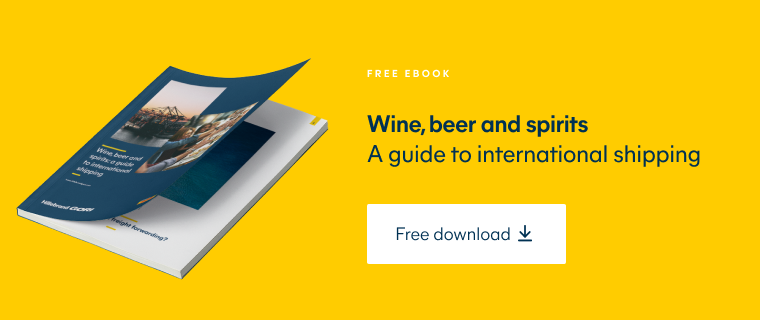Share this post
How international trade works and why it matters
International trade is a cornerstone of the global economy.
It provides access to a wider range of products for domestic and foreign markets, which drives economic growth. This growth has numerous benefits for businesses — from lower costs to increased profits.
One player in international trade is the wine industry with global exports reaching 37.6 billion euros ($41.22 billion) in 2022. The fact that different regions have different preferences and tastes for wine, creates a diverse market.
It’s important to understand how international trade works to maximize the potential of these benefits. But first, let’s take a look at some of the recent trends.
Recent developments in international trade
Industry experts consider maritime shipping a backbone of international trade and the global economy.
This is because countries that aren't landlocked make up approximately 92% of the overall value of international trade. Additionally, ships transport over 80% of the world's commodity cargo in terms of volume.
Here is an overview of recent developments in global freight procurement.
Europe to Asia/Middle East
Because of reduced demand, rates have decreased and are even lower than before the pandemic.
Container Trade Statistics reports that volumes from North Europe to Asia were down by 8% in Q1. While there was a slight increase in demand, overall stock levels are still high.
Regarding capacity, Mediterranean Shipping Company (MSC) and Maersk discontinued the "Shogun" service on the North Europe route in April. Meanwhile, MSC has brought back their "Dragon" service from the West Mediterranean (Med) to Asia as a stand-alone service.
MSC is introducing a new stand-alone service called "Swan." They will operate it using approximately 15 KTEU ships and will include direct calls in Klaipeda and Gdynia.
The market is still volatile due to low spot rates, but carriers are reducing capacity through blank sailing programs.
North America to Europe
Despite experiencing positive volume growth, spot rates have shown only limited decreases.
This trade route has seen an expansion of carrier capacity in late 2022, and these carriers are still looking for cargo, particularly in base ports. While there have been some minor issues with intermodal transport, they haven’t had a significant impact on the overall situation.
The Longshore and Warehouse Union (ILWU) and the Pacific Maritime Association (PMA) have reached a tentative agreement, bringing US West Coast ports back to normal operations. But because of drought, water levels at the Panama Canal were low, which caused delays of up to 10 days for ships waiting to pass through.
Thankfully, recent rains on June 25 have postponed any further drastic measures.
Asia to North America
In recent months, bookings have shifted back to West Coast ports, which have shorter transit times and lower rates.
This is a sign that schedule reliability is improving and things are returning to normal. Previously, bookings were diverted to the East Coast. Despite the recent ILWU and PMA negotiations that caused some disruptions, West Coast ports could function close to normal.
But carriers have reported that rates remain low and negatively affect their profits. To maintain or regain profitability, shipping lines have canceled 46 sailings in April and 32 in May, with more likely to be announced in the coming weeks.
Oceania to Asia
Demand for Australian products has increased by 10% in Q1 2023 as tensions between Australia and China have eased.
China has announced it will review tariffs imposed in May 2020, beginning with barley, with wine potentially under consideration. Although coal and iron ore exports have already surged, wine exports remain lower, although exports to Southeast Asia are increasing.
Auckland, New Zealand, has no equipment or space issues. But the primary wine ports in Napier and Nelson remain constrained because of limited service options and the unavailability of equipment.
South America to Europe
The situation in Chilean ports have improved, and Europe is experiencing very little congestion, so shipping schedules are more dependable now.
Continued low demand is causing continued pressure on ocean rates. Hapag Lloyd has added a tenth vessel to the Eurosal/SWX service.
To not increase weekly capacity, the service will turn in 10 weeks with slow steaming and the addition of a call in Le Havre (which was dropped in July 2021).
Meanwhile, the Panama Canal situation must be monitored. There were draft restrictions because of the early drought, but recent rainfalls have prevented these limitations.
Stay updated on the latest developments by downloading our global shipping trade lane dashboard.
Download the full global shipping trade lane dashboard.
Staying current on international trade is essential for the success of your business — so is understanding the fundamentals. Here is an overview of the basics.
What is international trade?
International trade is the exchange of products, like wine, beer and spirits and other goods between countries .
Trading products in this way allows countries to specialize in specific areas or access products they may not have available domestically. International laws or regulations and agreements each country has with its trading partners govern these transactions.
What are the types of international trade?
There are three primary types of international trade: import, export and entrepot.
Import involves buying and receiving products from another country. The top importers of wine are the United States (US), Germany and the United Kingdom (UK).
Export involves selling and sending products to another country. Italy, Spain and France are among the top exporters of wine.
Entrepot (a combination of import and export) involves buying and reselling products to another country. Some countries, like Singapore and Hong Kong, act as hubs for re-exporting wine to other markets, especially in Asia. Around 37% of wines that Hong Kong imports are re-exported, while Singapore re-exports 30% of its wines.
What is the role of international trade?
The importance of international trade can’t be overstated, especially with the world’s growing interconnectedness.
Here are some of the key roles it plays in the global economy.
Allocates resources efficiently
International trade allows countries to specialize in producing products they have a comparative advantage in.
This means that they can produce more efficiently than other countries using resources, such as:
Capital
Labor
Land
Technology
For example, a country may specialize in manufacturing and exporting cars, which involves significant capital investments. It can then use the profits from exports to import products that are more difficult or expensive to produce domestically.
This allows for increased cost saving that can be passed down to the consumers.
With wine, the specialization comes from climate conditions. If the climate is too hot and humid or too cold, grapes can’t grow.
Promotes economic growth
International trade stimulates economic activity by increasing the size of the market for producers and consumers.
It also encourages innovation and productivity by exposing companies to new ideas, technologies and competition.
Enhances welfare
International trade improves living standards by offering them more choices and opportunities.
It also reduces poverty by creating jobs and income for workers and entrepreneurs.
Fosters cooperation
International trade fosters cooperation among countries by creating mutual benefits and interdependence.
It also promotes peace and stability by reducing conflicts and tensions over scarce resources.
What are the benefits of international trade?
International trade offers many benefits for countries and regions that take part in it.
Here are four of the benefits.
1. Access to more products
International trade allows consumers to enjoy a wider range of products that aren’t available or are more expensive in their markets.
2. Lower prices and higher quality
International trade lowers the prices of products by increasing the supply and competition in the market.
It also improves the quality of products by encouraging innovation and efficiency among producers.
3. More income and employment
International trade creates more income and employment by expanding markets and production.
It helps diversify sources of income and reduce dependence on a single product or market.
4. More development and innovation
International trade stimulates development and innovation by providing access to new ideas, technologies and skills.
It also encourages investment and research by creating incentives and opportunities for companies and entrepreneurs.
How Hillebrand Gori can help with international trade logistics
International trade logistics is a complex process, and Hillebrand Gori offers services that can help make it simpler.
We specialize in managing the international trade of wine, beer and spirits. With our expertise and comprehensive global network, we can ensure an efficient international trading process so your beverage will reach its destination safely.
Contact us today to learn more.





